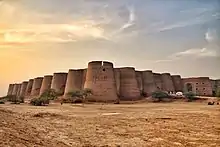Rawat Fort
Rawat Fort (Urdu: قلعہ روات) is an early 16th century fort in the Pothohar plateau of Pakistan, near the city of Rawalpindi in the province of Punjab. The fort was built to defend the Pothohar plateau from the forces of the Pashtun king Sher Shah Suri.[1]
| Rawat Fort قلعہ روات | |
|---|---|
| Rawat, Punjab, Pakistan | |
 A view of the fort's main entrance | |
 Rawat Fort قلعہ روات  Rawat Fort قلعہ روات | |
| Coordinates | 33.4981°N 73.1942°E |
| Type | Fort |
Location
It is 17 km east of Rawalpindi on Grand Trunk Road. The 2nd century Mankiala stupa can be seen from the roof of the fort's mosque. The fort is located approximately 50 miles from the vast Rohtas Fort, which had been built by Sher Shah Suri to establish control of the Gakhar region.
Etymology
Rawat Fort derives is named from the Arabic word Rabat (Arabic: رباط), meaning caravanserai - an inn for caravans.[2]
History
The fort was founded as a caravanserai in the 15th century by Salteen-e-Dehli, though the caravan itself may have been built atop a Ghaznavid-era fort that was established in 1036 CE.[3]
The caravanserai was then later fortified in the 16th century by the local Gakhar – warrior clan loyal to the Mughal emperor Humayun in order to defend the Pothohar plateau from Sher Shah Suri's forces.[4]
The fort was the scene of a battle between the Gakhar chief Sultan Sarang and Afghan king Sher Shah Suri in 1546.[5] Sultan Sarang was captured, tortured, and then executed at the fort by the forces of Sher Shah Suri, and then buried at the fort.[6]
Layout
The fort is almost in square form and has two gates. There is also a quadrangular building with a dome in the fort's inner area – an area which also contains many graves. Along the perimeter are several small cells, which may have originally been small rooms rented out to itinerant merchants.[7]
The fort also contains a mosque with three domes. The grave of the Gakkar chief, Sultan Sarang Khan is present within the fort.[8] His 16 sons, who died there fighting, are also buried inside the fort.
Conservation
The fort is federally protected as a Cultural Heritage Site of Punjab, and is managed by the Ministry of Information, Broadcasting and National Heritage. In November 2016, a conservation plan was commissioned for preservation of the fort.[9] 50 million rupees were allocated in March 2017 towards the first of two phases of conservation of the Rawat Fort.[10]
Gallery
.jpg.webp)
 The fort's eastern gate
The fort's eastern gate

 The tomb of Sarang Khan - a Gakhar chief who fought against Sher Shah Suri
The tomb of Sarang Khan - a Gakhar chief who fought against Sher Shah Suri A view of the fort's mosque
A view of the fort's mosque

 Parts of the fort are in a poor state of conservation
Parts of the fort are in a poor state of conservation
See also
| Wikimedia Commons has media related to Rawat Fort. |
References
- Malik, Iftikhar Haider (2006). Culture and Customs of Pakistan. Greenwood Publishing Group. ISBN 9780313331268.
- "The majestic Rawat Fort". Dawn. 17 August 2017. Retrieved 17 June 2017.
- "Historical Rawat Fort needs preservation". Pak Tea house. 16 June 2008. Retrieved 17 June 2017.
he information displayed at Rawat Fort’s by archaeology department reveals that it was built in the early 15th century by Salteen-e-Dehli. However there are some contradictions about the historical background of this fort. According to some historians, the fort was built by Sultan Masood, son of Sultan Mehmood Ghaznavi in 1036 AD while some other books of history reveal that Sarang Khan, the leader of Gakhar tribes in Pothohar, built the fort.
- Malik, Iftikhar Haider (2006). Culture and Customs of Pakistan. Greenwood Publishing Group. ISBN 9780313331268.
- "The majestic Rawat Fort". Dawn. 17 August 2017. Retrieved 17 June 2017.
- "FOrgotten Relic: Rawat Fort to be preserved". Express Tribune. Retrieved 17 June 2017.
- "The majestic Rawat Fort". Dawn. 17 August 2017. Retrieved 17 June 2017.
- Famous Forts in Pakistan
- "Work on conservation of Rawat Fort starts". The News. Retrieved 17 June 2017.
- "Rs 50m allocated for renovation of Rawat Fort". Pakistan Today. 5 March 2017. Retrieved 17 June 2017.
